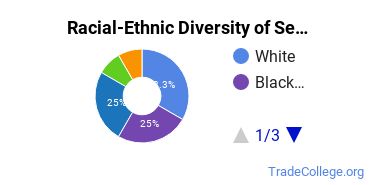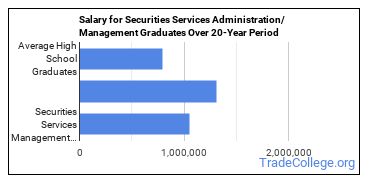Securities Services Management
Featured schools near , edit
Types of Degrees Securities Services Management Majors Are Getting
The following table lists how many securities services administration/management graduations there were in 2021-2022 for each degree level.
| Education Level | Number of Grads |
|---|---|
| Bachelor’s Degree | 363 |
| Basic Certificate | 164 |
| Undergraduate Certificate | 70 |
| Associate Degree | 17 |
What Can You Do With a Securities Services Management Major?
Below is a list of occupations associated with securities services administration/management:
| Job Title | Job Growth Rate | Median Salary |
|---|---|---|
| First-Line Supervisors of Protective Service Workers | 4.7% | $49,640 |
Who Is Getting an Associate’s Degree in Securities Services Management?
Racial-Ethnic Diversity
At the countrywide level, the racial-ethnic distribution of securities services administration/management majors is as follows:

| Race/Ethnicity | Number of Grads |
|---|---|
| Asian | 0 |
| Black or African American | 1 |
| Hispanic or Latino | 2 |
| White | 3 |
| International Students | 0 |
| Other Races/Ethnicities | 11 |
How Much Do Securities Services Management Majors Make?
Salaries According to BLS
The median salary for someone in a career related to securities services administration/management is $52,730. This median refers to all degree levels, so you may expect those with a more advanced degree to make more while those with less advanced degrees will typically make less.
To put that into context, according to BLS data from the first quarter of 2020, the typical high school graduate makes between $30,000 and $57,900 a year (25th through 75th percentile). The average person with a bachelor’s degree (any field) makes between $45,600 and $99,000. Advanced degree holders make the most with salaries between $55,600 and $125,400.
Online Securities Services Management Programs
The following table lists the number of programs by degree level, along with how many schools offered online courses in the field.
| Degree Level | Colleges Offering Programs | Colleges Offering Online Classes |
|---|---|---|
| Certificate (Less Than 1 Year) | 0 | 0 |
| Certificate (1-2 years) | 7 | 1 |
| Certificate (2-4 Years) | 0 | 0 |
| Associate’s Degree | 10 | 1 |
| Bachelor’s Degree | 10 | 6 |
| Post-Baccalaureate | 0 | 0 |
| Master’s Degree | 11 | 8 |
| Post-Master’s | 1 | 0 |
| Doctor’s Degree (Research) | 1 | 0 |
| Doctor’s Degree (Professional Practice) | 0 | 0 |
| Doctor’s Degree (Other) | 0 | 0 |
Is a Degree in Securities Services Management Worth It?
The median salary for a securities services administration/management grad is $52,730 per year. This is based on the weighted average of the most common careers associated with the major.
This is 32% more than the average salary for an individual holding a high school degree. This adds up to a gain of about $256,600 after 20 years!

Explore Major by State
Alabama
California
District of Columbia
Idaho
Kansas
Maryland
Mississippi
Nevada
New York
Oklahoma
South Carolina
Utah
West Virginia
Alaska
Colorado
Florida
Illinois
Kentucky
Massachusetts
Missouri
New Hampshire
North Carolina
Oregon
South Dakota
Vermont
Wisconsin
Trades Related to Securities Services Management
You may also be interested in one of the following majors related to securities services administration/management.
| Major | Number of Grads |
|---|---|
| Criminal Justice Studies | 46,895 |
| Criminal Justice | 31,754 |
| Criminal Justice & Police Science | 20,976 |
| Other Corrections & Criminal Justice | 3,988 |
| Corrections | 3,042 |
| Criminal Justice and Corrections, General | 1,323 |
| Security & Loss Prevention Services | 685 |
| Law Enforcement Investigation & Interviewing | 277 |
| Corrections Administration | 143 |
| Juvenile Corrections | 97 |
| Protective Services Operations | 19 |
| Critical Incident Response/Special Police Operations | 0 |
References
*The racial-ethnic minorities count is calculated by taking the total number of students and subtracting white students, international students, and students whose race/ethnicity was unknown. This number is then divided by the total number of students at the school to obtain the racial-ethnic minorities percentage.
- College Factual
- College Scorecard
- National Center for Education Statistics
- O*NET Online
- U.S. Bureau of Labor Statistics
- Usual Weekly Earnings of Wage and Salary Workers First Quarter 2020
More about our data sources and methodologies.
Featured Schools
 Request Info
Request Info
|
Southern New Hampshire University You have goals. Southern New Hampshire University can help you get there. Whether you need a bachelor's degree to get into a career or want a master's degree to move up in your current career, SNHU has an online program for you. Find your degree from over 200 online programs. Learn More > |
